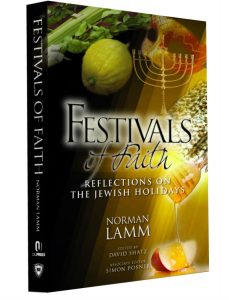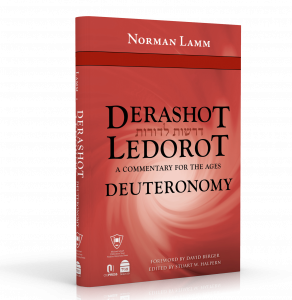Excerpted from Rabbi Shmuel Goldin’s Unlocking the Torah Text – Devarim, co-published by OU Press and Gefen Publishers
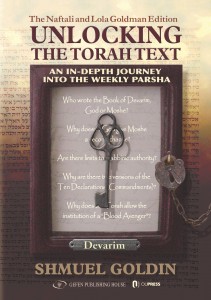 Second Edition?
Second Edition?
Context
Moshe’s recollections bring him back to the pivotal moment at Sinai, when, amidst thunder, lightning and the sounding of the shofar, God conveyed the Ten Declarations to the Israelites (see Shmot: Yitro 4).
As Moshe repeats these declarations in retrospect, a series of variations upon the original text recorded in the book of Shmot emerge. These textual discrepancies are inconsistent in nature. While the first and third declarations are repeated without any change at all, the other eight contain variations ranging from the nuanced to the substantial.
Questions
We have repeatedly noted (see Bereishit: Bereishit 3; Chayei Sara 3; Miketz 1) that whenever the Torah replicates a conversation or event, we are challenged to carefully compare the two versions presented. Invariably, the differences that emerge are important and instructive.
The passages before us, however, are uniquely problematic. With Moshe’s retrospective recording of the Ten Declarations, we are effectively confronted with a “second edition” of the divine communication that launched Revelation and changed the world.
How can we explain the textual discrepancies between the two versions of the Aseret Hadibrot? These declarations are, after all, God’s own words. A perfect God must have fashioned a perfect text through which to introduce His law to His people. Communication shared by such a Deity should need neither further editing nor improvement.
Our questions are further complicated by the singular nature of the book of Devarim as a whole. We have previously noted (see Devarim 1) that a spectrum of rabbinic opinion exists concerning the authorship of this volume. While all traditional scholars accept the divine nature of Devarim, they argue over Moshe’s role in the narrative. Does Devarim, they ask, uniquely consist of Moshe’s words, agreed to by God in retrospect; or does Moshe continue in the role that he has played until now, faithfully recording a text dictated by his Divine Master? Our position on these issues will
clearly affect our posture concerning the “dueling editions” of the Aseret Hadibrot. Numerous possibilities emerge. Did the textual emendations found in Devarim originate from God, from Moshe or from a partnership between the two? Is the source of all these variations consistent; or were some changes determined by God and others suggested by Moshe?
Approaches
A
Faced with these glaring issues, the rabbis accept as a given that the second version of the Aseret Hadibrot is neither an improvement upon nor a replacement for the first. Both versions are authentic. The changes that appear are, instead, designed to convey critical lessons and ideas that could not be derived from one consistent text.
Armed with this understanding, the scholars painstakingly study the differences between the two versions of the Aseret Hadibrot and offer explanations for each.
Our discussion must, of course, begin with a review of the textual discrepancies themselves.
| The Ten Declarations:
Version I (Shmot) |
The Ten Declarations:
Version 2 (Devarim) |
| 1. I am the Lord your God, Who has taken you out of the land of Egypt, from the house of slavery. |
1. I am the Lord your God, Who has taken you out of the land of Egypt, from the house of slavery. |
| 2. You shall have no other gods in My presence. You shall not make for yourself a graven image nor any likeness of that which is in the heavens above or on the Earth below or in the water beneath the Earth. You shall not bow down to them nor shall you serve them, for I am the Lord your God, a jealous God, Who visits the sin of fathers upon
children to the third and to the fourth generations of those who hate Me; and Who shows kindness to thousands of those who
love Me and to those who keep My commandments. |
2. You shall have no other gods in My presence. You shall not make for yourself a graven image of any likeness [the letter vav is omitted] of that which is in the heavens above or on the Earth below or in the water beneath the Earth. You shall not bow down to them nor shall you serve them, for I am
the Lord your God, a jealous God, Who visits the sin of fathers upon children and to the third and to the fourth generations of those who hate Me; and Who shows kindness
to thousands of those who love Me and to those who keep My commandments. |
| 3. You shall not take the name of the Lord, God, in vain, for the Lord will not absolve anyone who takes His name in vain |
3. You shall not take the name of the Lord, God, in vain, for the Lord will not absolve anyone who takes His name in vain. |
| 4. Remember the Sabbath day to sanctify it. Six days shall you labor and perform all your work; but the seventh day is Sabbath to
the Lord your God; you shall not do any work – you, and your son, and your daughter, your slave, and your maidservant, and your
animal, and your convert who is within your gates – for in six days the Lord made the heavens and the earth, the sea and all that
is within them, and He rested on the seventh day. Therefore the Lord blessed the Sabbath day and sanctified it. |
4. Safeguard the Sabbath day to sanctify it, as the Lord your God has commanded you. Six days shall you labor and perform all
your work; but the seventh day is Sabbath to the Lord your God; you shall not do any work – you, and your son, and your daughter, and your slave, and your maidservant, and your ox, and your donkey, and your every animal, and your convert who is within your gates;
in order that your slave and your maidservant shall rest like you. And you shall remember that you were a slave in the land of Egypt, and the Lord your God took you out from
there with a strong hand and an outstretched arm. Therefore, the Lord your God has commanded you to make the Sabbath day. |
| 5. Honor your father and your mother so that your days may be lengthened upon the land that the Lord your God gives to you. |
5. Honor your father and your mother, as the Lord your God has commanded you, so that your days may be lengthened and so that it
will be good for you, upon the land that the Lord your God gives to you. |
| 6. You shall not murder. |
6. You shall not murder. |
| 7. You shall not commit adultery. |
7. And you shall not commit adultery. |
| 8. You shall not steal. |
8. And you shall not steal. |
| 9. You shall not bear false witness against your fellow. |
9. And you shall not bear vain witness against your fellow. |
| 10. You shall not covet your fellow’s wife, nor his manservant, nor his maidservant, nor his ox, nor his donkey, nor anything that belongs to your fellow. |
10. And you shall not covet your fellow’s wife, and you shall not desire your fellow’s house, his field, nor his manservant, nor his maidservant, his ox, nor his donkey, nor anything that belongs to your fellow. |
The textual variations between the two versions of the Aseret Hadibrot can be summarized as follows:
1. On six occasions the conjunctive letter vav is added to the text (second, fourth, seventh, eighth, ninth, and tenth declarations), while on two occasions that letter is omitted (second and fifth declarations).
2. On two occasions the Torah substitutes one word for another (fourth and ninth declarations).
3. On three occasions the Torah adds a totally new phrase to the text (fourth and fifth declarations).
4. On two occasions the Torah substantially changes a passage of existing text (fourth and tenth declarations).
5. On two occasions slight written variations appear in the text, but are not vocalized (second and fifth declarations). [Note: As these variations do not result in a change in meaning, they are not reflected in the above translation. One of the variations results in the omission of another letter vav from the Devarim text, in a variant spelling of the word ya’arichun (shall be long; see below).]
B
In predictable fashion, the rabbis approach these textual variations from all ends of the interpretive spectrum, offering explanations that range from the mystical and Midrashic to the pragmatic and halachic. Differing perspectives concerning the divine or human origin of the emendations found in the Devarim text can also be discerned.
At one end of the spectrum, a fascinating Midrashic source takes note of an easily missed transformation in the Aseret Hadibrot as a whole. The first “edition” of the declarations, the rabbis point out, contains the entire Hebrew alphabet with the exception of one letter, the letter tet. This omission is subsequently rectified in the second “edition” through the insertion of two phrases: u’vizro’a netuya, “and with an outstretched arm” (third declaration) and u’lma’an yitav lach, “and so that it will be good for you” (fifth declaration). The words netuya and yitav, each containing the letter tet, provide one such letter to compensate for the original omission and one to complete the alphabet in the second edition of the dibrot. These nuanced distinctions, the rabbis explain, hardly occur by chance.
God intentionally omits a letter of the alphabet when the Aseret Hadibrot are first given at Sinai in order to protect the Israelites from the full consequences of their impending sin – the sin of the golden calf. By rendering His contract with the people incomplete and thereby technically “invalid,” God deliberately minimizes the impact of their subsequent betrayal of that contract.
A corrected version of the Sinaitic covenant, complete with all letters of the alphabet, is granted to the next generation of Israelites, as they stand poised to enter the land of Canaan and to succeed where their fathers failed.
A second Midrashic tradition attributes yet another omission in the initial version of the Aseret Hadibrot to potential consequences of the sin of the golden calf. The word tov (good), the rabbis note, is absent from the declarations inscribed on the tablets at Sinai. Had those tablets – ultimately smashed by Moshe in response to the sin of the golden calf – contained the word tov in any form, God would have been compelled to strip away all future “goodness” from the fledgling Jewish nation.
Any direct allusion to the concept of “goodness” must wait until a new, more deserving generation receives its version of the declarations. This condition is fulfilled when the phrase l’ma’an yitav lach, “so that it shall be good for you,” is incorporated into the fifth declaration recorded in the book of Devarim.
Finally, a third Midrash focuses on the addition of a total of four conjunctive letters, vavs, in the Devarim text. The numerical value of the letter vav is six. The inclusion of these four vavs, therefore, carries the cumulative effect of symbolically adding the number twenty-four to the dibrot. Twenty-four is also the number of volumes contained in Tanach, the Jewish scriptural canon. The entire corpus of Torah She’bi’chtav, the Written Law, is thus alluded to within the text of the Ten Declarations.
It should be noted that, as is often the case with Midrashim, all these sources ignore the literal significance of the additions in question, choosing instead to see the inclusions as “carriers” of divine lessons that are external to the straightforward meaning of the text.
C
While the Midrash offers countless other observations concerning these textual variations, we now turn our attention to the opposite end of the interpretive spectrum. Here, numerous scholars struggle to discern logical explanations for the emendations to the dibrot. Particularly noteworthy in this regard is the general approach of Rabbi Yehuda Loew, the Maharal of Prague.
As previously noted (Devarim 1, Approaches A), the Maharal maintains that Moshe’s role is transformed with the advent of the book of Devarim. The first four books of the Torah, the Maharal explains, are designed to reflect God’s perspective, as the transmitter of the law. The text of those volumes is therefore transmitted by God directly, literally speaking through Moshe. The book of Devarim, however, is different. This text is devised to more closely parallel the perception of man, the recipient of the law. Now Moshe serves as a prophetic messenger, receiving God’s messages and recording them in his own words. Devarim presents God’s truths – seen through Moshe’s eyes.
The emendations found in the Devarim version of the Aseret Hadibrot thus reflect Moshe’s desire to add “commentary” to the text. Upon receiving God’s word and perceiving its thrust, Moshe sets out to shape the text as necessary, so that all of God’s messages will be clear to the nation.
While the Maharal’s overall approach to the variations in the dibrot is rooted in logic, however, this scholar’s explanation of the individual emendations remains somewhat esoteric.
As a case in point, the Maharal notes that the phrase l’ma’an yitav lach, “so that it shall be good for you,” is added to the fifth declaration in the Devarim edition of the dibrot. This phrase is omitted from the first edition, the Maharal explains, because of the unique nature of Revelation at Sinai. In that setting, God speaks to the nation “face to face,” addressing the divine dimension of the Israelites’ souls. The heavenly dimension in mortal man, however, is by nature incomplete and cannot be referred to by the term tov (good), a term that uniformly connotes wholeness and completeness. The phrase l’ma’an yitav lach, therefore, with its reference to “goodness,” can only be included in the second edition of the dibrot, when Moshe addresses the Israelites as earthly equals, one mortal speaking to another.
The Maharal also observes that in contrast, the next phrase, u’l’ma’an ya’arichun yamecha, “so that your days will be long,” is included in the fifth declaration of both editions of the dibrot. Strangely, however, the word, ya’arichun (shall be long) is written incompletely in the Devarim edition, with a vav omitted and a smaller letter, yud, added. This emendation, the Maharal explains, is created by Moshe to reassure the nation. Generally, when the Torah speaks of a lengthy period of time, the connotation is one of sorrow. The time period involved may actually be short, but it “feels endless,” due to the difficult nature of its passage. Conversely, when the text speaks of a short duration of time, the days spoken of are pleasurable.The Torah thus informs us that Yaakov toiled seven years in expectation of marrying Rachel, yet the time period “seemed to him a few days because of his love for her.”
Moshe, recognizing the negative connotation associated in the text with a lengthy period of time, deliberately shortens the word ya’arichun. The reward for performing the commandment of kibbud av va’em, he conveys, will be “long days” that don’t possess the usual character of “long days” in the Torah. An individual who honors his parents will be rewarded by God with a long yet gratifying life. He will be blessed with an abundance of pleasurable days that will not seem endless.
D
Numerous other commentaries follow the Maharal’s general approach to the text in Devarim, yet offer specific explanations that cleave closer to the pshat.
Rabbi Shimshon Raphael Hirsch, for example, maintains that Moshe tailors the dibrot in Devarim in order to address the unique challenges faced by a generation about to enter its Promised Land.
By adding the phrase l’ma’an yitav lach…al ha’aretz, “so that it shall be good for you…on the land,” to the declaration concerning obedience to parents, Moshe conveys that “every contemporary generation in Israel [will only achieve] happiness and prosperity if it takes over, with honoring obedience, the tradition of its history and laws from the hands of its parents, as a heritage to be carried on forever…”
Hirsch also offers a logical explanation for Moshe’s joining together of the last five dibrot – the prohibitions against murder, adultery, theft, false testimony and coveting another’s property – into one long collective statement in the Devarim text. He does so, Hirsch argues, in order to include and prohibit all crimes against the property of others “in one and the same utterance of God.” In addition, by connecting these transgressions, Moshe consciously roots all such crimes in the last declaration, the ban on “coveting” the property of another. Envy towards others, Moshe emphasizes to the people, inexorably leads to greater sin. Such emphasis, Hirsch explains, is particularly necessary at this juncture, as the people prepare to leave behind the controlled, centralized authority of the desert encampment in favor of a scattered existence over the whole of a country.
E
Once we accept Hirsch’s suggestion that Moshe tailors the dibrot in Devarim to suit the needs and perceptions of a new generation, we can offer other explanations for some of the variations found in the declarations.
Moshe adds, for example, the phrase “as God commanded you” specifically to the fourth and fifth declarations dealing with the observance of Shabbat and kibbud av va’em, obedience to parents, respectively. Based on a Talmudic tradition, Rashi and others explain that this phrase references the fact that the mitzvot of Shabbat and kibbud av va’em were actually introduced to the nation shortly after the parting of the Reed Sea, before the Revelation at Sinai.
If these commandments preceded the Sinaitic Revelation, however, why is the phrase “as God commanded you” not included in the first edition of the dibrot communicated at Sinai, as well? By the time Revelation occurred, these imperatives had already been shared.
We might argue, perhaps, that, for the generation of the Exodus, Revelation at Sinai was a stand-alone event, designed to impress the people with its power and strength. As we have noted before, this generation, shaped in the cauldron of Egyptian slavery, relates to God through the primitive dimension of yira, fear (see Bamidbar: Korach 6, Approaches B, Points to Ponder; Chukat 2, Approaches D; Chukat 3, Approaches H). Immediacy and power, rather than slow, painstaking processes, speak to the erstwhile slaves. The Ten Declarations are therefore presented in isolation to the generation of the Exodus, as a powerful independent statement of binding law.
Their children, however, come to see God through the continuing prism of ahava, love. Raised for almost four decades under God’s watchful eye, surrounded by the Clouds of Glory, nurtured on the heaven-sent manna, patiently traveling towards a destiny and a destination, this generation now understands that a true relationship develops over time, in incremental fashion. Against this backdrop they are able to view the unfolding of the law itself as a process, with Sinai as a dramatic but by no means isolated event. This generation has witnessed laws enacted following the Revelation at Sinai during their own wilderness travels. They can readily understand that the development of law could have preceded Sinai, as well.
The shift of generations potentially explains the greater emphasis on material possessions in the second edition of the dibrot, as well. In the fifth declaration, as recorded in Devarim, the commandment of Shabbat applies not only to “your animal,” but to “your ox, and your donkey, and your every animal.” In the tenth declaration the list of possessions that we are forbidden to covet expands to include “your fellow’s house” and “his field.” Additionally, while the Israelites are prohibited from “coveting” another’s possessions in the first dibrot, in the second version they are also warned not to “desire” those possessions. The generation of the wilderness has begun to comprehend the reality of personal ownership in a way that their parents, raised in slavery, could scarcely imagine. Moshe therefore specifies material possessions in greater detail, including “real estate” where applicable. He also warns this new generation not only against “coveting”
that which is clearly beyond their reach, but against “desiring” prohibited possessions that they believe they could potentially attain.
Finally, the shifting emphasis in the fourth declaration from creation to the Exodus as the philosophical foundation for Shabbat observance may also reflect generational change. Momentous events can only be fully appreciated and understood in retrospect. To the generation of the Exodus, therefore, Shabbat is presented as a remembrance of the creation of the world. To the wilderness generation, however, Shabbat also becomes a remembrance of the Exodus itself.
F
No discussion concerning the variations between the two editions of the Aseret Hadibrot would be complete without mention of the most famous distinction: the transition from “Zachor (remember) the Sabbath day to keep it holy…” in the first edition to “Shamor (safeguard) the Sabbath day to keep it holy…” in the second. Rabbinic commentary on this glaring shift is extensive. One basic approach, however, stands out, weaving Midrashic and halachic analysis into a fascinating interpretive tapestry.
The rabbis begin with a foundational Midrashic suggestion: “‘Remember’ and ‘safeguard’ were delivered in one utterance.”
These two imperatives, the rabbis suggest, were miraculously communicated at Sinai simultaneously. Rashi and others explain this claim to mean that the two words were somehow pronounced by God as one, yet each word was separately and distinctly discerned by the assembled Israelites.
What, however, is the import of these two separate imperatives? What specific obligations do the commandments of “remembering” and “safeguarding” the Sabbath entail?
While various suggestions are offered within rabbinic literature, one basic approach is of particular significance. The commandment to “remember” the Shabbat obligates us to perform the positive acts that underscore the significance of the Sabbath day, such as the recitation of Kiddush (the blessing proclaiming the sanctity of Shabbat recited over a cup of wine). The commandment to “safeguard” the Shabbat, on the other hand, obligates us to observe the restrictions that define the day. By refraining from thirty-nine basic prohibited activities and their derivatives on Shabbat, we effectively “safeguard” the sanctity of the day.
Combining the legal distinction between these two imperatives with the Midrashic tradition that they were transmitted in “one utterance,” the rabbis arrive at a practical halachic conclusion. Although women are normally exempt from time-bound positive biblical commandments, they are nonetheless obligated in the biblical mitzva of Kiddush. This exception to the rule, the rabbis explain, emerges from the divinely ordained connection between zachor and shamor: “All those who are included in the commandment to ‘safeguard [the Shabbat]’ are also included in the commandment to ‘remember [the Shabbat].’ ”
Since women are obviously as responsible as men in maintaining the sanctity of the Sabbath through refraining from prohibited activity, they are also obligated in the positive acts, such as Kiddush, that underscore the holiness of the day.
Taken together, the rabbis maintain, the imperatives of zachor and shamor summarize each Jew’s relationship with Shabbat. Shamor directs our attention to the restrictions through which we create the behavioral boundaries that define the circumference of the Sabbath day. Zachor commands us towards the positive actions through which we fill the newly created circle with meaning.
G
Our search for answers concerning the two editions of the Aseret Hadibrot has been extensive but hardly exhaustive. Numerous other sources comment on these textual emendations, and further insights remain to be revealed through continuing study and analysis.
Points to Ponder
How does a divinely ordained legal system transcend the ages? We examined this question in depth in our review of the structure and process of the Oral Law (see Shmot: Yitro 5). In short, however, the secret lies in the delicate balance between continuity and change – in immutable foundational laws that remain open to constant interpretation and application across the generations.
Can it be that the Torah hints at this essential balance through the differing editions of the Aseret Hadibrot? No section of text would seem riper for rigidity than these declarations, pronounced at Sinai by a powerfully present God. Nonetheless, the Torah allows for controlled transformation even in this divinely transmitted code. While the laws remain unchanged in the second version, new ideas are added and the text is consciously shaped to better address a new generation.
Apparently, the balance that preserves the law is embedded in the law from the outset.
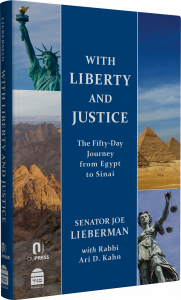 Day 31: Law and Morality
Day 31: Law and Morality
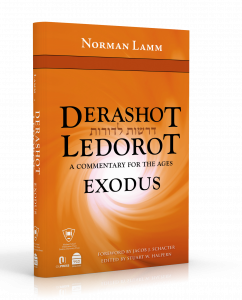
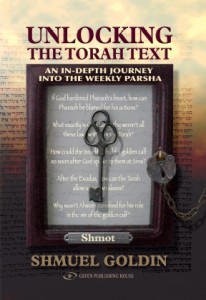

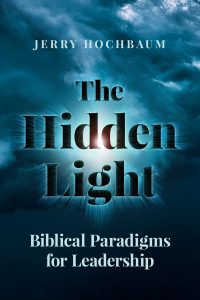 Galut and Geulah: Intertwined Processes
Galut and Geulah: Intertwined Processes